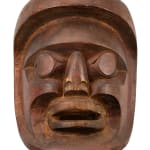-
Artworks
MUNGO MARTIN (1879-1962) KWAKWA̱KA̱ʼWAKW
Beaver Echo Mask, c. 1950scarved and stained cedar wood, 12.25 x 9.25 x 8.75 in (31.1 x 23.5 x 22.2 cm), measurements reflect dimensions with inset snout
signed, "MUNGO MARTIN".LOT 137
ESTIMATE: $15,000 — $25,000
PRICE REALIZED: $31,200.00
A world record for the artist at auction.Further images
A central figure in 20th century Northwest Coast art, Mungo Martin was taught to carve by his stepfather Yakudlas Charlie James (see lots 111 & 112), and was himself an...A central figure in 20th century Northwest Coast art, Mungo Martin was taught to carve by his stepfather Yakudlas Charlie James (see lots 111 & 112), and was himself an important early teacher to artists Ellen Neel (see lot 113) and Henry Hunt (1923-1985), among others. In the 1940s and 1950s, Martin was hired to restore and recreate monumental poles for both the Museum of Anthropology at UBC (MOA) and the British Columbia Provincial Museum (now Royal BC Museum). Martin worked with a number of notable anthropologists during his career, including Audrey and Harry Hawthorn, Wilson Duff, and Ida Halpern. He was also a key figure in the lifting of the potlatch ban in 1951, hosting the first “legal” public potlatch since 1885 two years later, in 1953 [1].
Echo masks are created and used by Central Coast British Columbia First Nations. According to Hawthorn, “Echo masks were fitted with sets of wooden mouthpieces representing different characters. A small basket fastened at the waist carried the extra pieces. Using the dance blanket as a concealment, the dancer lowered his head and secretly fitted in a new mouthpiece” [2]. This echo mask probably dates to the 1950s and is carved in red cedar with a single mouthpiece representing a beaver snout. There are three similar echo masks by Martin’s apprentice, Henry Hunt, that feature single bird beak attachments in the collections of the Harvard Peabody Museum of Archaeology and Ethnology (995-29-10/73519A), the Smithsonian National Museum of the American Indian (25/3871), and the MOA (3259/10 a-b). It’s likely that the beaver snout was the only attachment created for this mask, as the MOA notes that “Hunt only made one mouthpiece for the masks for sale... as a simplified version of the Echo masks” [3], which probably applies to this Martin mask as well. With its strong lines and robust forms, this mask is an excellent example by a truly iconic Northwest Coast artist.
1. Hawker, Tales of Ghosts, 2002
2. Hawthorn, Kwakiutl Art, 1979, p. 211.
3. UBC Museum of Anthropology, Echo Mask, object no. 3259/10 a-b.
Christopher W. Smith
References: For additional information on the artist, see Phil Nuytten, The Totem Carvers: Charlie James, Ellen Neel, and Mungo Martin, (Vancouver:Panorama Publications, 1982); Ronald Hawker, Tales of Ghosts: First Nations Art in British Columbia, 1922-61, (Vancouver: UBC Press, 2002); and Audrey Hawthorn, Kwakiutl Art, (Vancouver: Douglas & McIntyre, 1979) For the MOA echo mask example, see Museum of Anthropology at UBC Online Database. Echo Mask, Item number 3259/10 a-b. http://collection-online.moa.ubc.ca. Accessed 5 October 2022.
Provenance
Skinner Auctions, Boston, MA, 09 November 2013, Lot 272;
Private Collection,San Diego, CA;
A Vancouver Collection.
Join our mailing list
* denotes required fields
We will process the personal data you have supplied in accordance with our privacy policy (available on request). You can unsubscribe or change your preferences at any time by clicking the link in our emails.














